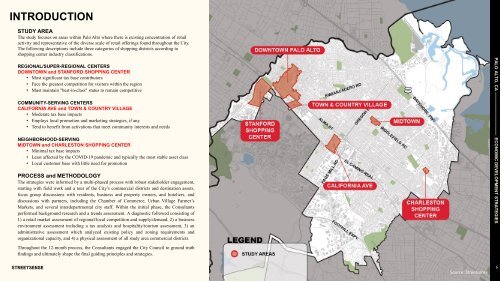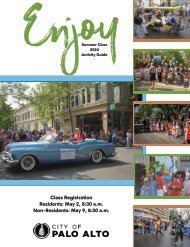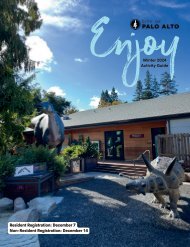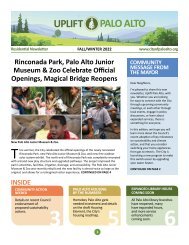Palo Alto Economic Development Strategies
Create successful ePaper yourself
Turn your PDF publications into a flip-book with our unique Google optimized e-Paper software.
INTRODUCTION<br />
STUDY AREA<br />
The study focuses on areas within <strong>Palo</strong> <strong>Alto</strong> where there is existing concentration of retail<br />
activity and representative of the diverse scale of retail offerings found throughout the City.<br />
The following descriptions include three categories of shopping districts according to<br />
shopping center industry classifications.<br />
REGIONAL/SUPER-REGIONAL CENTERS<br />
DOWNTOWN and STANFORD SHOPPING CENTER<br />
• Most significant tax base contributors<br />
• Face the greatest competition for visitors within the region<br />
• Must maintain "best-in-class" status to remain competitive<br />
COMMUNITY-SERVING CENTERS<br />
CALIFORNIA AVE and TOWN & COUNTRY VILLAGE<br />
• Moderate tax base impacts<br />
• Employs local promotion and marketing strategies, if any<br />
• Tend to benefit from activations that meet community interests and needs<br />
NEIGHBORHOOD-SERVING<br />
MIDTOWN and CHARLESTON SHOPPING CENTER<br />
• Minimal tax base impacts<br />
• Least affected by the COVID-19 pandemic and typically the most stable asset class<br />
• Local customer base with little need for promotion<br />
PROCESS and METHODOLOGY<br />
The strategies were informed by a multi-phased process with robust stakeholder engagement,<br />
starting with field work and a tour of the City’s commercial districts and destination assets,<br />
focus group discussions with residents, business and property owners, and hoteliers, and<br />
discussions with partners, including the Chamber of Commerce, Urban Village Farmer’s<br />
Markets, and several interdepartmental city staff. Within the initial phase, the Consultants<br />
performed background research and a trends assessment. A diagnostic followed consisting of<br />
1) a retail market assessment of regional/local competition and supply/demand, 2) a business<br />
environment assessment including a tax analysis and hospitality/tourism assessment, 3) an<br />
administrative assessment which analyzed existing policy and zoning requirements and<br />
organizational capacity, and 4) a physical assessment of all study area commercial districts.<br />
PALO ALTO, CA —————————— ECONOMIC DEVELOPMENT STRATEGIES<br />
Throughout the 12-month process, the Consultants engaged the City Council to ground truth<br />
findings and ultimately shape the final guiding principles and strategies.<br />
Source: Streetsense<br />
6
















